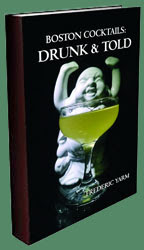1/4 oz Luxardo Maraschino Liqueur
1/2 oz Grapefruit Juice
1/2 oz Simple Syrup
Shake with ice, strain into a flute glass, top with Champagne (2 oz 90-Plus Cellars Prosecco), and garnish with a grapefruit twist.

quality versus quantity does not have to be a winner-take-all proposition.






The Sound of the Waves
• 1 1/2 oz Aviation Gin
• 1 1/2 oz Pimm's #1
• 1/2 oz Oregano Syrup (*)
• 1/2 oz Lemon Juice
Shake with ice, strain into a Collins glass with 2 oz soda water, add a straw, and garnish with a lemon wheel and oregano sprig.






























 The 2017 collection of 855 drink recipes, bartender tributes, and essays on hospitality from CocktailVirgin's Frederic Yarm. Available at Barnes and Noble and Amazon.
The 2017 collection of 855 drink recipes, bartender tributes, and essays on hospitality from CocktailVirgin's Frederic Yarm. Available at Barnes and Noble and Amazon. The 2012 collection of 505 drink recipes, techniques, and Boston bar recommendations from Frederic Yarm. Available at Amazon and Barnes and Noble.
The 2012 collection of 505 drink recipes, techniques, and Boston bar recommendations from Frederic Yarm. Available at Amazon and Barnes and Noble.